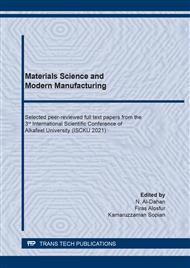[1]
Huawei Q, Hongya F, Zhenyu H and Yang S 2019 Biomaterials for bone tissue engineering scaffolds: a review RSC Adv. 9 26252-26262.
DOI: 10.1039/c9ra05214c
Google Scholar
[2]
Census B 2010 Health and Nutrition Washington 117.
Google Scholar
[3]
Guilin L, Yufei M, Xu C, Lixin J, Mingming W, Yang H, Yanfeng L, Haobo P and Changshun R 2017 13-93 bioactive glass/alginate composite scaffolds 3D printed under mild conditions for bone regeneration RSC Adv. 7 11880–11889.
DOI: 10.1039/c6ra27669e
Google Scholar
[4]
Xin L, Rahaman M, Hilmas G and Sonny B 2013 Mechanical properties of bioactive glass (13-93) scaffolds fabricated by robotic deposition for structural bone repair Acta Biomater 9 7025-34.
DOI: 10.1016/j.actbio.2013.02.026
Google Scholar
[5]
Elisa F, Gianpaolo S, Cristina B, Enrica V and Francesco B 2019 Bread-Derived Bioactive Porous Scaffolds: An Innovative and Sustainable Approach to Bone Tissue Engineering molecules 24 2954.
DOI: 10.3390/molecules24162954
Google Scholar
[6]
Rahaman N, Day E, Bal S, Fu Q, Jung B, Bonewald F and Tomsia P 2011 Bioactive glass in tissue engineering Acta Biomater 7 2355–73.
DOI: 10.1016/j.actbio.2011.03.016
Google Scholar
[7]
Aylin M 2015 Preparation, in vitro mineralization and osteoblast cell response of electrospun 13-93 bioactive glass nanofibers Mater Sci. Eng. 53 262 -271.
DOI: 10.1016/j.msec.2015.04.037
Google Scholar
[8]
Liu X, Rahaman M, Fu Q and Tomsia A 2012 Porous and strong bioactive glass (13–93) scaffolds prepared by unidirectional freezing of camphene-based suspensions Acta Biomater 8 415–23.
DOI: 10.1016/j.actbio.2011.07.034
Google Scholar
[9]
Doiphode N, Huang T, Leu M and Rahaman M 2011 Freeze extrusion fabrication of 13–93 bioactive glass scaffolds for bone repair J Mater Sci Mater Med 22 515–23.
DOI: 10.1007/s10856-011-4236-4
Google Scholar
[10]
Huang T, Doiphode N, Rahaman M, Leu M, BAL B and Day D 2011 Porous and strong bioactive glass (13–93) scaffolds prepared by freeze extrusion fabrication Mater Sci Eng 31 1482–90.
DOI: 10.1016/j.msec.2011.06.004
Google Scholar
[11]
Deliormanli A and Rahaman M 2012 Direct-write assembly of silicate and borate bioactive glass scaffolds for bone repair J Eur Ceram Soc. 32 3637–46.
DOI: 10.1016/j.jeurceramsoc.2012.05.005
Google Scholar
[12]
Fadilah D, Rosaniza I, Normahira M and Mariatti J 2018 Techniques for fabrication and construction of three-dimensional bioceramic scaffolds: Effect on pores size, porosity and compressive strength Ceramics International 44 18400–18407.
DOI: 10.1016/j.ceramint.2018.07.056
Google Scholar
[13]
Bahaa M, Mahmoud A and Abdullah M 2015 Characterization, in situ electrical conductivity and thermal behavior of immobilized PEG on MCM-41 Electrochem. Sci. 10 4873-4887.
Google Scholar
[14]
Sin D, Miao S, Liu G, Fan W, Chadwick G, Yan C and Friis T 2010 Polyurethane (PU) scaffolds prepared by solvent casting/particulate leaching (SCPL) combined with centrifugation. Materials Science and Engineering C: Materials for Biological Applications 30 78-85.
DOI: 10.1016/j.msec.2009.09.002
Google Scholar
[15]
Agda A, Dickson A, Luisa L, Sandhra M, Herman S and Marivalda M 2013 Synthesis, characterization and cytocompatibility of spherical bioactive glass nanoparticles for potential hard tissue engineering applications Biomed. Mater 8 025011.
DOI: 10.1088/1748-6041/8/2/025011
Google Scholar
[16]
Xin L, Mohammed N, Yongxing L, Sonny B and Lynda F 2013 Enhanced bone regeneration in rate calvarial defects implanted with surface-modified and BMP-loaded bioactive glass (13-93) scaffolds Acta biomater 7 7506-7517.
DOI: 10.1016/j.actbio.2013.03.039
Google Scholar


